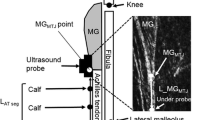Abstract
Limb immobilization or confinement to bed results in a severe atrophy and weakness of lower leg muscles. Full recovery of muscle strength and physical function is rare and may impact the patient’s outcome. Studies performed on rodents have demonstrated that the deleterious structural and functional adaptations which occur during muscle deconditioning can be counteracted through adequate physiological stimuli. Thus, based on this fundamental work, we developed a device that combines mechanical stimulation of proprioceptors located in the plantar sole and Achilles’ tendon. The device is adapted to patients immobilized and confined to bed. Stimulations can be applied on muscle in passive state. The protocol is non-invasive and is well accepted by patients. This paper presents the technical features of the device, as well as preliminary results of the first clinical study. This device might allow considering new therapeutic strategies for prevention of atrophy in many pathologies.






Similar content being viewed by others
References
Abercromby F, Amonette WE, Layne CS, McFarlin BK, Hinman MR, Paloski WH (2007) Vibration exposure and biodynamic responses during whole-body vibration training. Med Sci Sports Exerc 39:1794–1800
American Thoracic Society (2002) ATS statement: guidelines for the six-minute walk test. Am J Respir Crit Care Med 166:111–117
Burke D, Hagbarth KE, Lofstedt L, Wallin BG (1976) The responses of human muscle spindle endings to vibration during isometric contraction. J Physiol (Lond) 261:695–711
Burnfield JM, Courtney DF, Mohamed OS, Perry J (2004) The influence of walking speed and footwear on plantar pressures in older adults. Clin Biomech (Bristol, Avon) 19:78–84
Chiu MC, Wu HC, Chang LY (2013) Gait speed and gender effects on center of pressure progression during normal walking. Gait Posture 37:43–48
Davies AT, Rutherford IC, Thomas DO (1987) Electrically evoked contractions of the triceps surae during and following 21 days of voluntary leg immobilization. Eur J Appl Physiol Occup Physiol 56:306–312
De-Doncker L, Picquet F, Falempin M (2000) Effect of cutaneous receptor stimulation on muscular atrophy developed in hindlimb unloading by tail suspension. J Appl Physiol 89:2344–2351
Dehail P, Duclos C, Barat M (2008) Electrical stimulation and muscle strengthening. Ann Readapt Med Phys 51:441–451. doi:10.1016/j.annrmp.2008.05.001
Duchateau J (1995) Bed rest induces neural and contractile adaptations in triceps surae. Med Sci Sports Exerc 27:1581–1589
Falempin M, Fodili-In Albon S (1999) Influence of brief daily tender vibration on rat soleus muscle in non-weight-bearing situation. J Appl Physiol 87:3–9
Garcia N, Sabater-Navarro JM, Gugliemeli E, Casals A (2011) Trends in rehabilitation robotics. Med Biol Eng Comput 49:1089–1091
Giaquinto S, Ciotola E, Margutti F (2007) Gait in the early days after total knee and hip arthroplasty: a comparison. Disabil Rehabil 29:731–736
Hessert MJ, Vyas M, Leach J, Hu K, Lipsitz LA, Nowak V (2005) Foot pressure distribution during walking in young and old adults. BMC Geriatr 5:8
Hillstrom HJ, Song J, Kraszewski AP, Hafer JF, Mootanah R, Dufour AB, Chow BS, Deland JT 3rd (2013) Foot type biomechanics part 1: structure and function of the asymptomatic foot. Gait Posture 37:445–451
Kavounoudias A, Roll R, Roll JP (2001) Foot sole and ankle muscle inputs contribute jointly to human erect posture regulation. J Physiol (Lond) 532:869–878
Kyparos JB, Macefield VG (2007) Vibration sensitivity of human muscle spindles and golgi tendon organs. Muscle Nerve 36:21–29
Kyparos A, Feeback DL, Layne CS, Martinez DA, Clarke MS (2005) Mechanical stimulation of the plantar foot surface attenuates soleus muscle atrophy induced by hindlimb unloading in rats. J Appl Physiol 99:739–746
Lord SR, Clark RD, Webster IW (1991) Postural stability and associated physiological factors in a population of aged persons. J Gerontol 46:M69–M76
Maurer A, Mergner T, Bolha B, Hlavacka F (2001) Human balance control during cutaneous stimulation of the plantar soles. Neurosci Lett 302:45–48
Mounier Y, Tiffreau V, Montel V, Bastide B, Stevens L (2009) Phenotypical transitions and Ca2+ activation properties in human muscle fibers: effects of a 60-day bed rest and countermeasures. J Appl Physiol 106:1086–1099. doi:10.1152/japplphysiol.90695.2008
Nankaku M, Tsuboyama T, Kakinoki R, Kawanabe K, Kanzaki H, Mito Y (2007) Gait analysis of patients in early stages after total hip arthroplasty: effect of lateral trunk displacement on walking efficiency. J Orthop Sci 12:550–554
Picquet F, De-Doncker L, Falempin M (2003) Expression of myosin heavy chain isoforms in rat soleus muscle spindles after 19 days in hypergravity. J Histochem Cytochem 51:1479–1489
Rasch A, Dalén N, Berg HE (2010) Muscle strength, gait, and balance in 20 patients with hip osteoarthritis followed for 2 years after THA. Acta Orthop 81:183–188. doi:10.3109/17453671003793204
Reiner R, Nef T, Colombo G (2005) Robot-aided neurorehabilitation of the upper extremities. Med Biol Eng Comput 43:2–10
Roll JP, Vedel JP (1982) Kinaesthetic role of muscle afferents in man, studied by tendon vibration and microneurography. Exp Brain Res 47:177–190
Shaffer SW, Harrison AL (2007) Aging of the somatosensory system: a translational perspective. Phys Ther 87:193–207
Vahtrik A, Gapeyeva H, Aibast H, Ereline J, Kums T, Haviko T, Märtson A, Schneider G, Pääsuke M (2012) Quadriceps femoris muscle function prior and after total knee arthroplasty in women with knee osteoarthritis. Knee Surg Sports Traumatol Arthrosc 20:2017–2025
Vandervoort AA, Hayes KC (1989) Plantarflexor muscle function in young and elderly women. Eur J Appl Physiol Occup Physiol 58:389–394
Vodovnik L (1981) Therapeutic effects of functional electric stimulation of extremities. Med Biol Eng Comput 19:470–478
Acknowledgments
This work was supported in part by OSEO, French State Agency for innovation (n°A1007033N). The authors would like to thank Lamine Kone (TELICE group, University Lille 1), for his contribution to the electromagnetic compatibility tests, Régis Logier and Pascal Chaud (CI-CIT, Lille) for the risk assessment, and Noel Barrett for his efforts to improve the language of the manuscript.
Author information
Authors and Affiliations
Corresponding author
Rights and permissions
About this article
Cite this article
Canu, MH., Fryziel, F., Noel, JP. et al. A new device combining mechanical stimulation of plantar sole and Achilles’ tendon to alleviate the consequences of muscle deconditioning. Med Biol Eng Comput 54, 733–741 (2016). https://doi.org/10.1007/s11517-015-1363-y
Received:
Accepted:
Published:
Issue Date:
DOI: https://doi.org/10.1007/s11517-015-1363-y




